#today in science news
Explore tagged Tumblr posts
Text


sooo… nobody’s gonna talk about how every time hughie kills someone & gets their blood all over himself the next thing happening is butcher killing someone & getting coated in blood too? literally every. single. time.
murder husbands i guess?
also i was SO fucking cheering for hughie to kill that man. i need this boy morally RUINED
#anybody relating?#yeah i finally had time to watch the new ep and it was SO SO GOOD#im beginning to like homelander’s character more and more#literally the only time i can say that homelander was based was today#‘they were only doing their job🥺’ my ass!! they literally brutally tortured a child for their depraved so-called science research#also john is stronger than all of us because if i were in his shoes then even after murdering my tormentors i would’ve NOT forgave them#the boys#the boys tv#hughie campbell#billy butcher#butchie#hughie and butcher are husbands idc what anyone says
768 notes
·
View notes
Text
"If you can't question it it's not science. It's propaganda." U.N. Owen.
#quote of the day#quote of today#if#questions#science#propaganda#dare to question#think#dare to think#sapere aude#stay curious#think for yourself#think twice#question everything#use your brain#use your head#freedom of thoughts#crimethink#thought crime#1984#2024#brave new world#in the light of certain events#think about it
398 notes
·
View notes
Text

Partial lunar eclipse 14.03.2025
#my photo#lunar#lunar eclipse#moon#astrophotography#astronomy#photography#sky#night sky#today#today news#photographers on tumblr#science#space
49 notes
·
View notes
Text
i learned that the Palmar Reflex is a primal instinct that develops in the womb. This instinct allows newborns to support their entire body weight on their own, similar to animal species. Most babies lose between 5 and 6 months.
There is also a reflection that if a sleeping baby is tossed into the air, it will instinctively open like an eagle to break its fall. Scientists say this is evidence that humans were once tree-dwellers.

431 notes
·
View notes
Text
youtube
Liquid Protodermis seem similar to water at first glance, but it actually has some very strange and often contradictory properties when you look into it. In this video, we take a closer look at those properties and establish a theory to explain those contradictions.
This theory includes maths, material science and fluid dynamics - but also hot tubs and Rahi poop!?
Liquid Protodermis may be strange, but theories about it may prove to be even stranger…
New Bionicle Science investigations every month. What part of Bionicle lore do you want to see investigated next?
If you want to support the Knowledge Tower you can donate on Ko-Fi: https://ko-fi.com/theknowledgetower
#bionicle#lego bionicle#science#bionicle science#the knowledge tower#youtube#lego#Protodermis#Liquid Protodermis#there will also be a new short later today when i finish editing it#so look forward to that#Youtube
70 notes
·
View notes
Text
Starseed Apples
“Here you go,” I said, putting down the last box. “Uncut fabric, plumbing supplies, and three cases with a fungus biohazard label. Do I even want to know what’s in those?” I cast a curious look at my fellow human as I handed over the signing pad. She was shorter and rounder than I was, dressed in a crisp uniform of a type I didn’t recognize. Big pockets everywhere.
She signed with a wry grin. “Those are dirt.”
“Dirt?” I repeated, looking around the admittedly spotless loading dock of this particular space station. “Dirt warrants a biohazard here?”
“Oh, you have no idea,” she said, handing the pad back. “Organic mulch that could contain anything from decomposed animals to fungus to poop? With uncountable amounts of bacterial life and potential germs? We’re lucky they only focused on the mold aspect!”
“Hm, good point,” I said.
Zhee, who was busy moving boxes off the hover sled, muttered something disparaging. I expected him to complain about how gross it all was, since he was always the first to point out when humans did something to offend his bug-alien sensibilities, but it sounded like he was griping about the strict station rules this time.
The human continued. “We have to keep a clean room between the greenhouse area and everything else. Even there, most things are in pots. We’ve got a great crop from Johnny Starseed right now!”
I’d heard that name before. “Oh, was he the one who sells little potted—”
“Apple trees, yeah,” she said. “Tiny and convenient, but they make an impressive number of apples as long as you feed ‘em quality dirt.” She bent down to pat a box.
Zhee finished freeing the sled. “Reasonable business plan,” he said, sounding almost complimentary.
“The guy named himself after Johnny Appleseed,” I told Zhee. “A human from centuries ago who got famous for traveling around and setting up apple orchards on Earth. Everybody likes a guy who brings food wherever he goes. And drink — I think some of those apples were supposed to be the cider variety.”
Zhee flicked his antennae. “Sounds like a very human thing to do,” he said drily.
“Have you tried the Starseed Reds?” the other human asked. “They’re very good.”
“No I haven’t, but I’d like to!” I said. “I’ve heard good things. I was kind of hoping to cross paths with him at some point. I wouldn’t mind a tiny apple tree in my quarters. Of course, the cat might get at it, and I’d probably have to find a grow lamp…”
She opened a boxy hip pocket, and pulled out the shiniest red apple I’d seen in a while. “Here you go.”
“Thank you!” I said, taking it eagerly. “That’s very generous!”
She waved it off. “Like I said, we’ve got a big crop. And I’ve got a different one that I’m saving for when I get off shift.” From another pocket, she produced a red apple with distinct orange stripes. “Which should be as soon as I get the supplies back to base.”
I laughed. “Is that the booze kind? I didn’t think those were real!”
“Oh yes,” she said with relish, putting it back in the pocket. “Starseed Cider Apples, no fermenting required!”
Zhee cocked his head, faceted eyes looking at both of us. “Poisonous apples?”
“Alcoholic apples,” I corrected, knowing full well that he considered that to be the same thing.
Zhee pushed the hover cart back toward the ship with a dramatic head tilt and antennae swirl. “Now that sounds like a human thing to do.”
“Well, you’re not wrong there,” I said with a smile. I thanked the other human and followed him, taking a bite of my non-alcoholic apple. It really was good.
~~~
The ongoing backstory adventures of the main character from this book. More to come!
#hm new posting interface#not a fan#SURELY there's a way to do this without having to add in the paragraph breaks manually#good thing today's story is a short one#annnnnyways...#my writing#the Token Human#humans are weird#haso#hfy#eiad#humans are space orcs#writeblr#science fiction#short stories
379 notes
·
View notes
Text



Today in 1882, Thomas Edison, and his partner Edward H. Johnson created the very first string of electric lights intended for a Christmas Tree. People originally illuminated their trees with candles, which as you can guess was a dangerous practice leading to many house fires. Edison and Johnson hand-wired 80 red, white, and blue bulbs, and hung them around the Christmas tree. During this time many people mistrusted electricity, it wasn't until 1895, when President Grover Cleveland had the White House family Christmas tree illuminated by hundreds of multicolored bulbs, people started to change their minds. It is important to remember for the time being, families would have to hire a wire man which would have cost $2,000 in today's dollars. It wouldn't be until 1903 when General Electric began to sell preassembled kits of stringed Christmas lights, as a more affordable option.
#histoire#history#history in the making#history is awesome#history of science#history stuff#historyposting#today in history#history lesson#connecticut#thomas edison#christmas lights#christmas#news#history will say they were best friends#vintage#xmas#history is all you left me#history lover#history geek#fyp#history drama#history daily#history photos#history has its eyes on you#history of music#history is important#history is fun#usa#history things
139 notes
·
View notes
Text
The future doesn’t come to you, it’s something you create.
#future#multi dimensional#multi dimensional thought#new thought#new science#time#relativity#time relativity#discipline#action#will to power#motivation#will#strength#goals#motivated#motivate#literature#words#word of the day#information#today#power of now#thought#philosophy
6 notes
·
View notes
Text
You know what one of the nicest things about Doctor Who is? It's that, at its core, this show is fundamentally a sci-fi show, and how whenever they're running away from fighting aliens and monsters and what not, they never beat them by using force or physical conflict (unlike every new and old generic marvel movie) these silly guys (gn) always find a way to outsmart them, or find an actually science based solution, or talk them down. And that just shows they understood the essence and genre of the show, and I think that's so cool
#i think today i feel like bashing marvel studios#the few i can think of are the christmas special for the second season#aka the sword fighting scene#doctor who#dw#new who#nuwho#doctorwho#marvel#marvel studios#mcu#the doctor#scifi#science
79 notes
·
View notes
Text
"You shouldn't be eating processed food, I already said its not healthy for you. Im teaching you the right thing but you choose the wrong path, and it can cause obesity-" NOT THIS AGAIN HOLY SHIT💔💔💔💔💔💔💔
#oh this is about my science teacher btw!!!#WE'RE LEARNING SOMETHING NEW AND HE STILL REPEATS THE SAME THING OVER AND OVER AGAIN#also he was faking a lot of accent today. “I stayed years there so-” mf 2 years is not making you sound like that.#deerdoeb talks !!
4 notes
·
View notes
Text
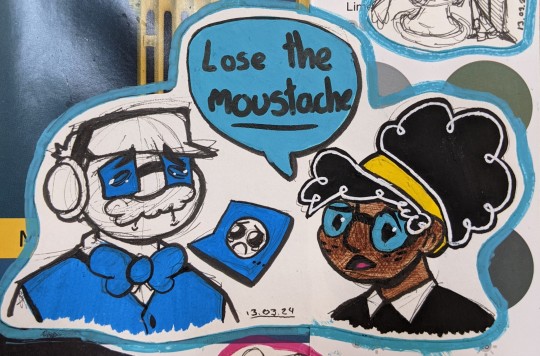
I can't wait for their reunion
(Robutler doodles under the cut)


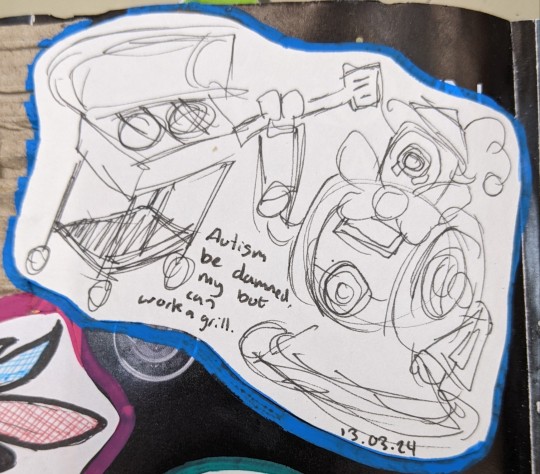
These all have definitely been done before but I couldn't get them out my head
#sorry for no art post yesterday I hate double posting#but great news guys i had my autism assessment today (we all know the results)#(look at this blog)#alas reggie and prism are so funny to me. it makes me violent I have so many thoughts#sedate me or something idk#i digress prism i love you (i have drawn her every day since i designed her and I say that every time)#but it's true i DO LOVE HER#i finished ieytd 3 for myself yesterday and i would wave every time I'd see her#which is an improvement from ieytd 2 where whenever i saw juniper i called him a faggot#i love him i promise#anyways something something i found a great tragic science wives song and. i need someone to give me an excuse to talk about it or -#- i shall wilt like a pretty flower#ANYWAYS#ieytd#i expect you to die#[agent moose's art]#reginald crane#the handler#roxanna prism#roxana prism#robutler
26 notes
·
View notes
Text
Wildfire & Environmental Health
Here's a few interesting studies I read recently at work that were related to wildfire. Y'all know I find wildfire to be an interesting topic, and I'm an environmental scientist who primarily works in the public health sphere, so I thought I would share them!
The first is about metals found in wildfire suppressants. You know, the stuff they drop from planes?

This one immediately caught my interest since I primarily work in theings related to lead, which is a heavy metal. I had not thought about heavy metals in wildfire suppressants before, but it did not suprise me given our track record with fire fighting products in the past (PFAS in fire fighting foam and asbestos as a flame retardant....)
This study looked at fire suppressants approved by the US Forest Service and consumer use to see if it could contribute to increased heavy metals found in soil and water in areas following a wildfire. They looked at vanadium, chromium, manganese, copper, arsenic, cadmium, antimony, barium, thallium, and lead and found councentrations 4–2,880 times greater than drinking water regulatory limit. At least 8, if not all, of the above metals were found in every fire suppressant tested. The products themselves are not meant to be ingested, obviously, but the concern was that if it were many times above the drinking water maximum contaminant level, that it could still be high enough to impact drinking water quality if it ran off into a reservoir used for that. The Forest Service does have buffer zones around bodies of water where fire suppressants should not be dropped, but accidents happen frequently. They estimated that "fire retardant application in the U.S. contributed approximately 380,000 kg of toxic metals to the environment between 2009 and 2021."
All fire suppressants must be tested by the US Forest Service and have their full ingredient list disclosed, but for public facing material safety data sheets up to 20% can be considered "proprietary" and not disclosed. Chromium and cadmium are effective as aluminum corrosion inhibitors, so they have been added to prevent the product from corroding the aircraft's tanks. Chromium, cadmium, lead, copper, manganese, arsenic have all been documented a contaminants in phosphate ores, which could explain some of the heavy metal concentration in fire suppressants that contain phosphates (but not all of them contained phosphates.) Leaching from metal storage/production tanks could also potentially explain some of the metals in the fire suppressants.
This is an interesting article to me. The authors did not mention it, but I want to note that heavy metal contamination can be just as harmful to wildlife as it is to humans, so even if this contamination did not actually enter human drinking water, it could still kill wildlife. This is also just a terrible glimpse into the way we damage ecosystems. Decades of total fire suppression and poor forest management has lead to increasingly worse wildfires with more fuel to burn, and climate change is fueling through hotter and drier seasons, changed weather patterns, and more. Worse wildfires means fires that are harder to control, and thus fires that need increased use of fire suppressants....which are also toxic. Sigh.
The other one is a new study I just saw today, about the potential link between wildfire smoke inhalation and dementia:
This study looked at 1.2 million people in Southern California to see if long term exposure to wildfire fine particulate matter (PM2.5) was associated with dementia diagnosis. PM2.5 exposure is already known to be a risk factor for dementia but wildfire smoke is an increasingly common source of it that can have different chemical and physical properites than other sources of PM2.5. Wildfire-generated PM2.5 now accounts for "over 70% of total PM2.5 exposure on poor air quality days in California."
They found that for every one microgram increase in wildfire PM2.5 per cubic meter of air over the course of 3 years, the odds of dementia diagnosis rose by 18%. For comparison, the odds of dementia diagnosis for the same parameters of non-wildfire PM2.5 only rise by 3%. (This is compared to everyone's baseline risk, so it is still a fairly small risk over the total population.) The difference could because wildfire smoke participles often have higher concentrations of oxidative or inflammatory compounds, have a smaller average particle size, and typically spike intermittently at high levels at certain parts of the year. Low income communities and people of color were noted to be at higher risk—potentialy due to housing quality (air filtration) and systemic discrimination compounding their risks later in life.
This study is very full of statistics and analysis, so in full disclosure some of my summary is also based off a paywalled article I read first on it. It is an intersting study for sure—I would not have guessed that wildfire smoke specifically had so much higher of an impact than other sources of particulate matter.
Uh, happy Wednesday!
#i nearly said happy friday lol <- brain only knows i'm getting off work today. does not comprehend holiday#environmental science#guys i wanna use my professional experience in lead and my laser focused personal interest in wildfire and unite them to study this more#i tried to summarize these the best i could <3 you can probably find like an actual news article on it though that does it better
9 notes
·
View notes
Text
This is how we live now
Tents ⛺️ through this winter
Tents through this cold
Our little children is starving and cold
We need the world help
Your support always matters ❤️
Link to Donate in my bio
Thank you 🙏🏽
#palestine#art#black and white#design#fashion#japan#history#science#kpop#programming#save palestine#save gaza#vintage#blog#north gaza#halloween#gif#gravity falls#digital art#sports#advertising#quotes#tumblr fyp#architecture#artwork#original character#x reader#zelda#news#today
8 notes
·
View notes
Text
i learned who is the mother of the animal kingdom that sacrifices the most in the world

The female octopus is the most selfless mother in the world
Because after laying about 50,000 eggs at once, it keeps them for up to 6 consecutive months.
During this period, the mother refrains from eating any food in order to protect the eggs and not move around during this time.
After 6 months, the eggs hatch and the mother dies of starvation. That is why the female octopus is considered the most selfless mother in the world.
Follow my Twitter/X account for more: www.x.com/toastbutteregg
I follow back!
349 notes
·
View notes
Note
Hello Starlo. How are you doing today?



(also sorry for answering a bit late! Thx for the ask!)
(i'm workin on a blog for asks to Science Starlo since well- it's better to have a side blog for that than to do It in your main, so I'll make a post once I have it all done!)
#ik its not too difficult to make a new blog but i got many stuff to do and yea#probs will make it today though#QUICKLY.#(because maths hates me and i dont want it to kill little old me/hj)#anyways thx for the ask!!#uty au#science starlo au#sci starlo au#science starlo#ask box#asks are closed here!!#(but keep asking me questions but NOT related to these okay?)#undertale yellow#starlo#starlo uty#uty starlo#undertale yellow au#underblog💛
19 notes
·
View notes
Text
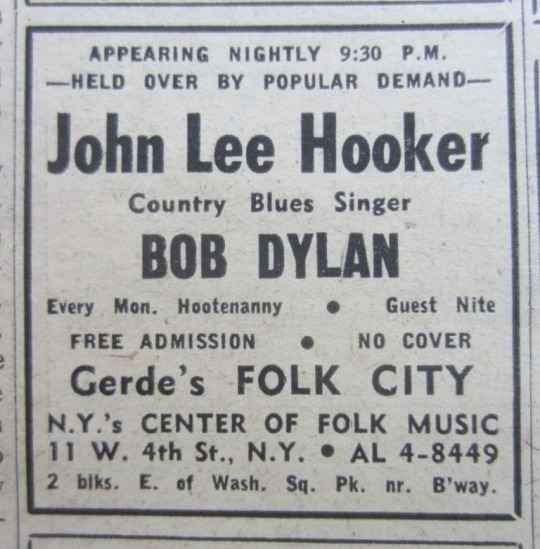
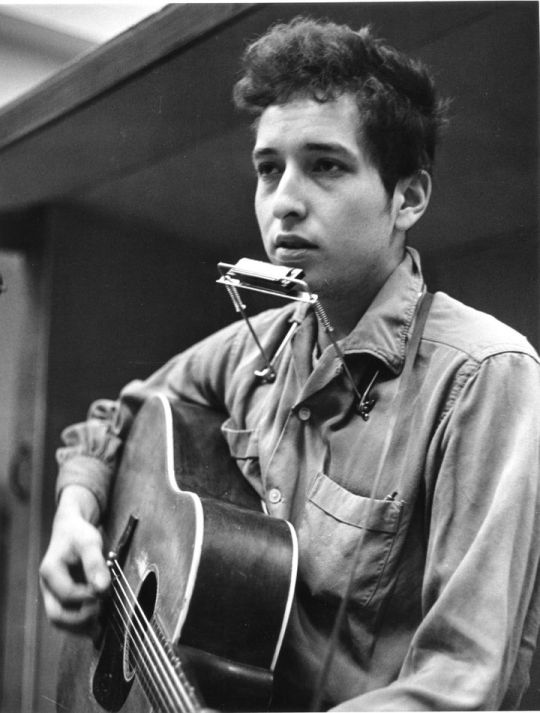
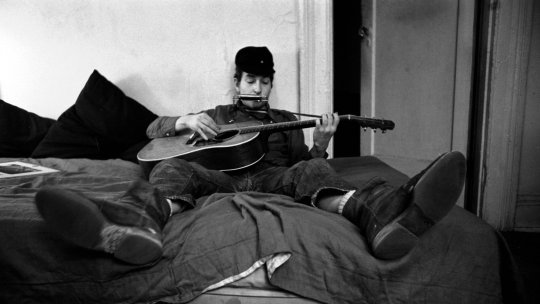
Today in 1961: Bob Dylan took to the stage in New York for his first major gig at Gerde’s Folk City. Dylan was hired to open for none other than the blues icon John Lee Hooker, for a two-week engagement that would go down in history. His setlist included classics like "House of the Rising Sun," "Song to Woody," and "Talkin' Hava Negeilah Blues." He played two other songs that night, identified only as "unknown Woody Guthrie song" and "a black blues," showcasing his incredible range and versatility as a musician. The audience was blown away, including folk legend Dave Van Ronk who attended Dylan's first show and declared, "he was absolutely remarkable." It was a night that would go down in history, but unfortunately, none of the concerts were recorded and amateur recordings have never surfaced.
#histoire#history#history in the making#history is awesome#history of science#history stuff#historyposting#today in history#history lesson#connecticut#new york#new your city#bob dylan#john lee hooker#musician#musica#60s music#70s music#music#rock music#folk rock#folk music
21 notes
·
View notes